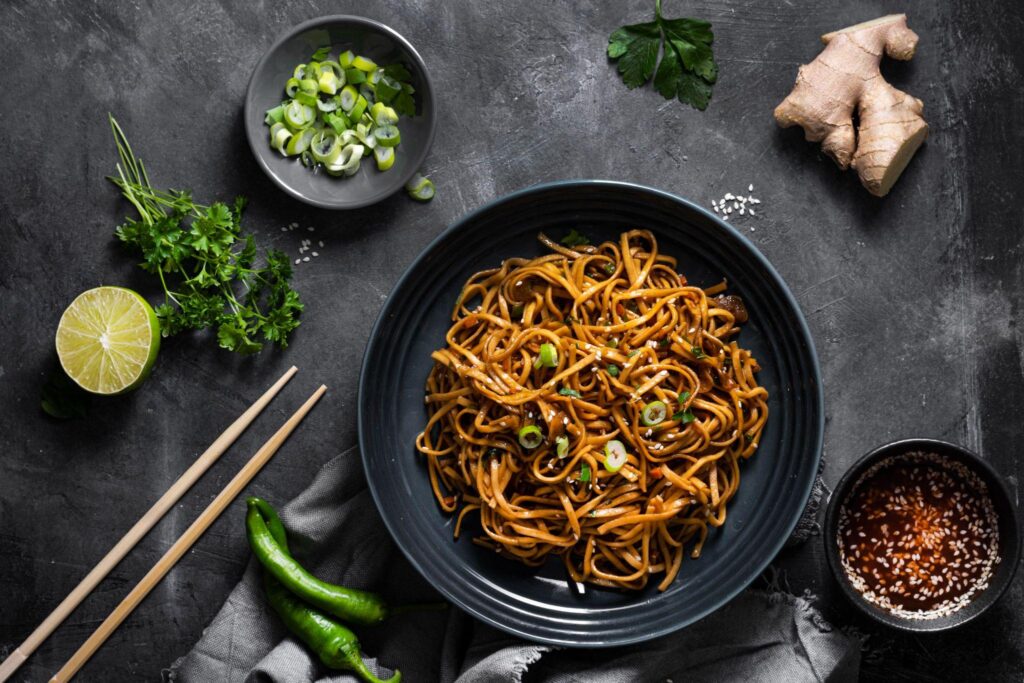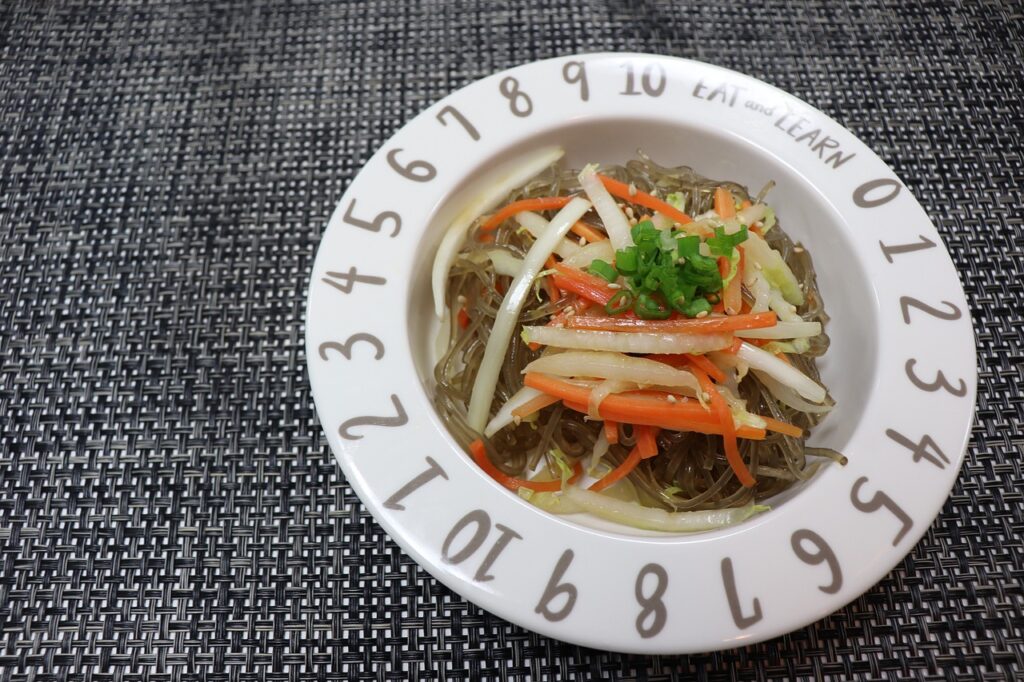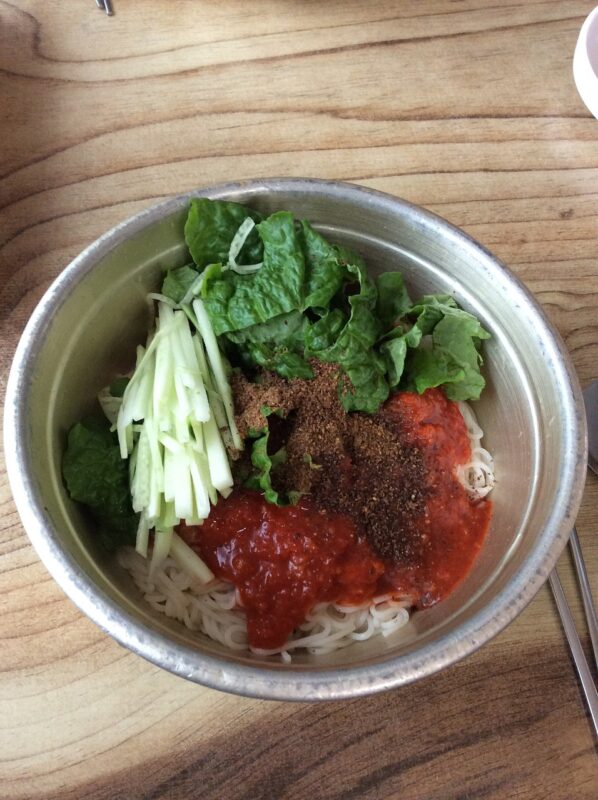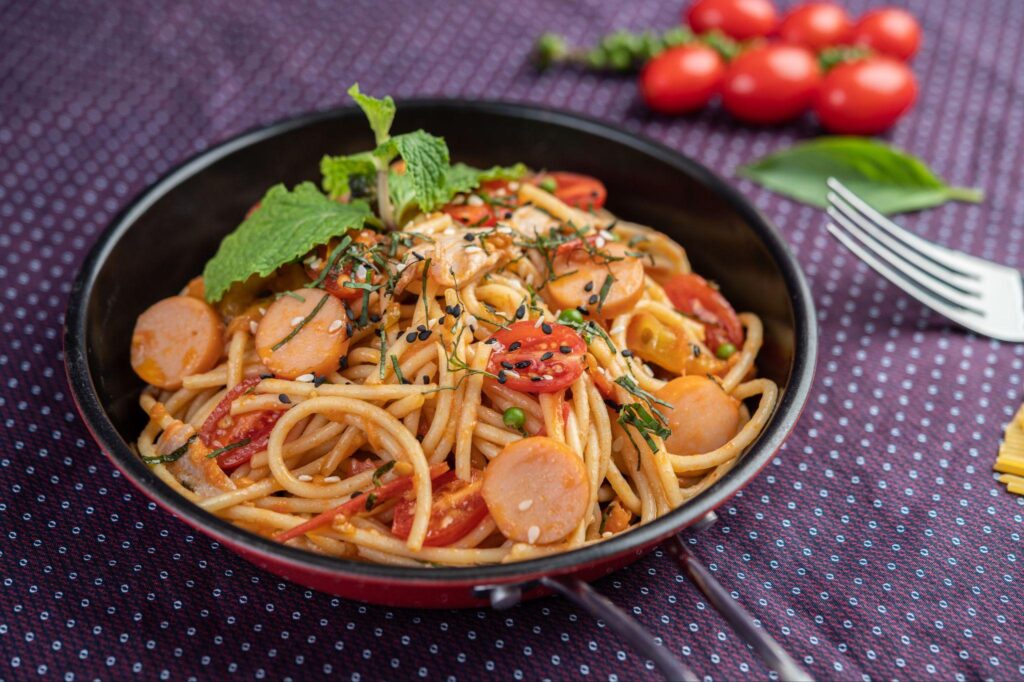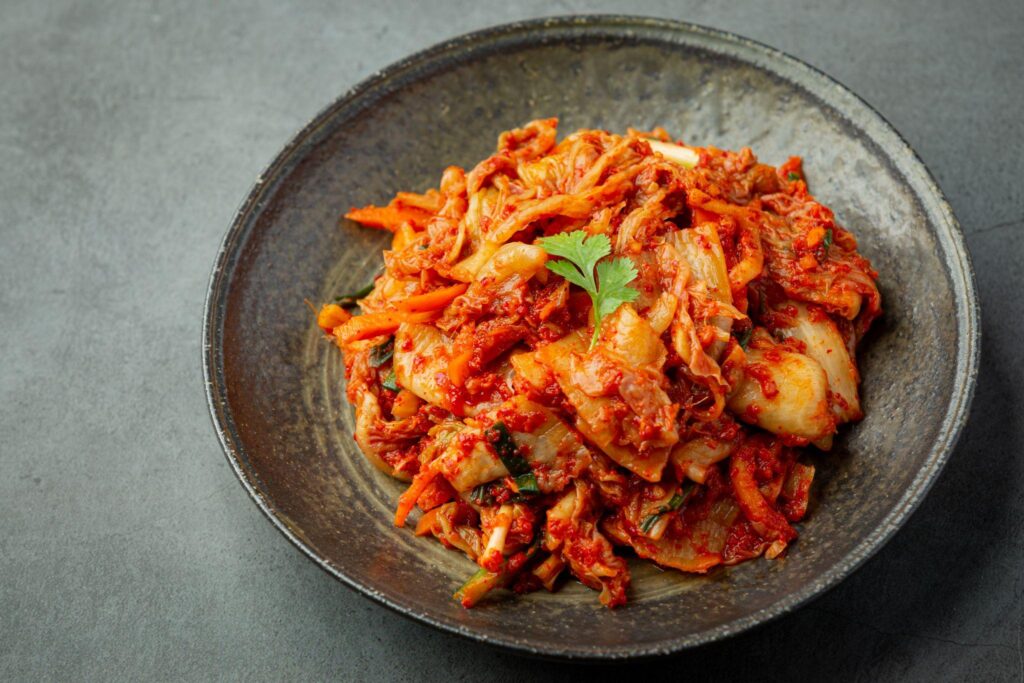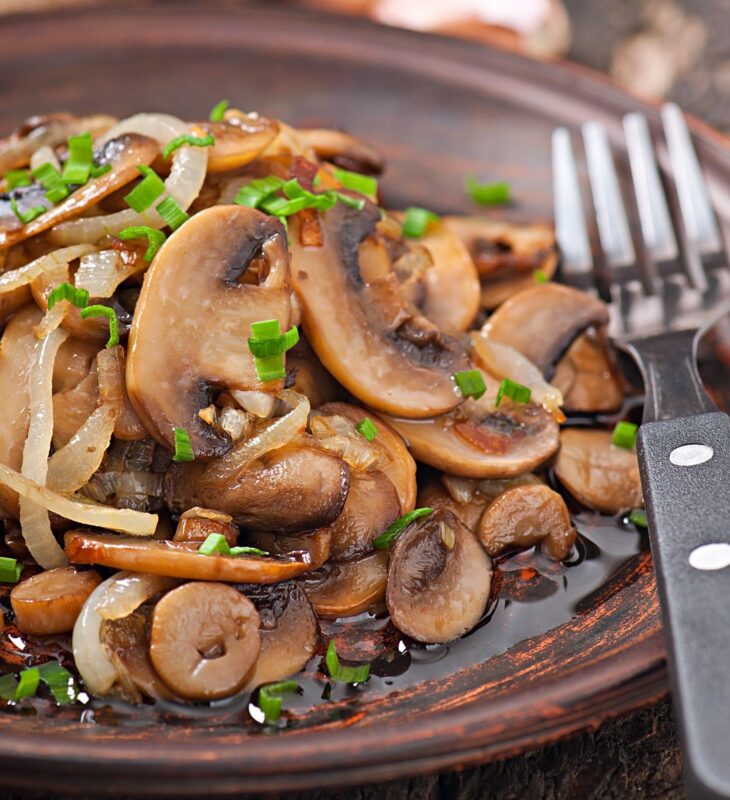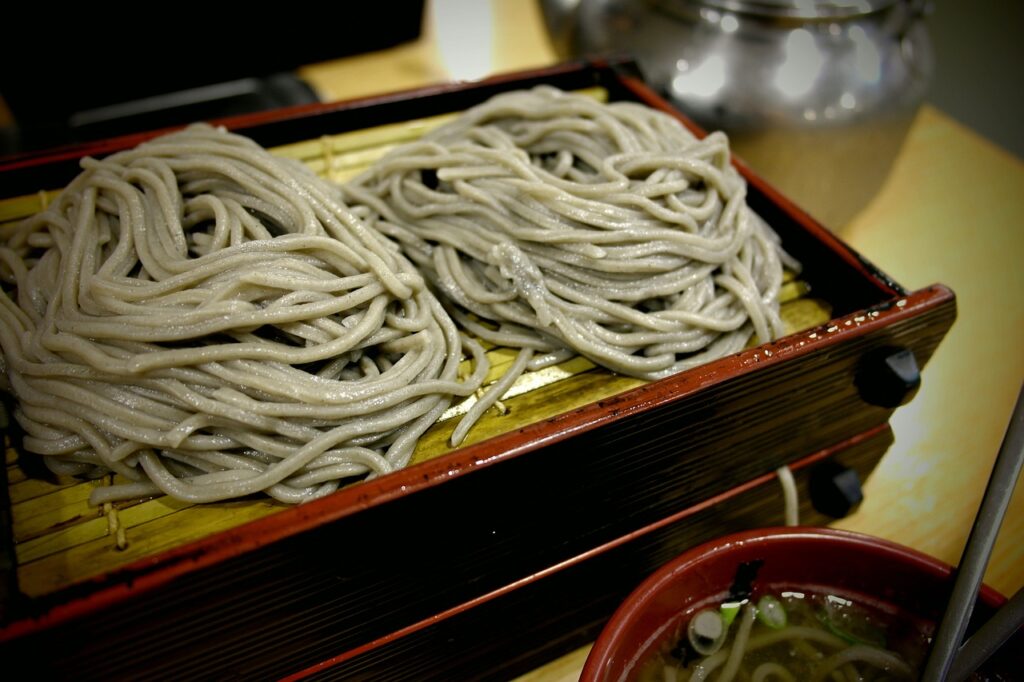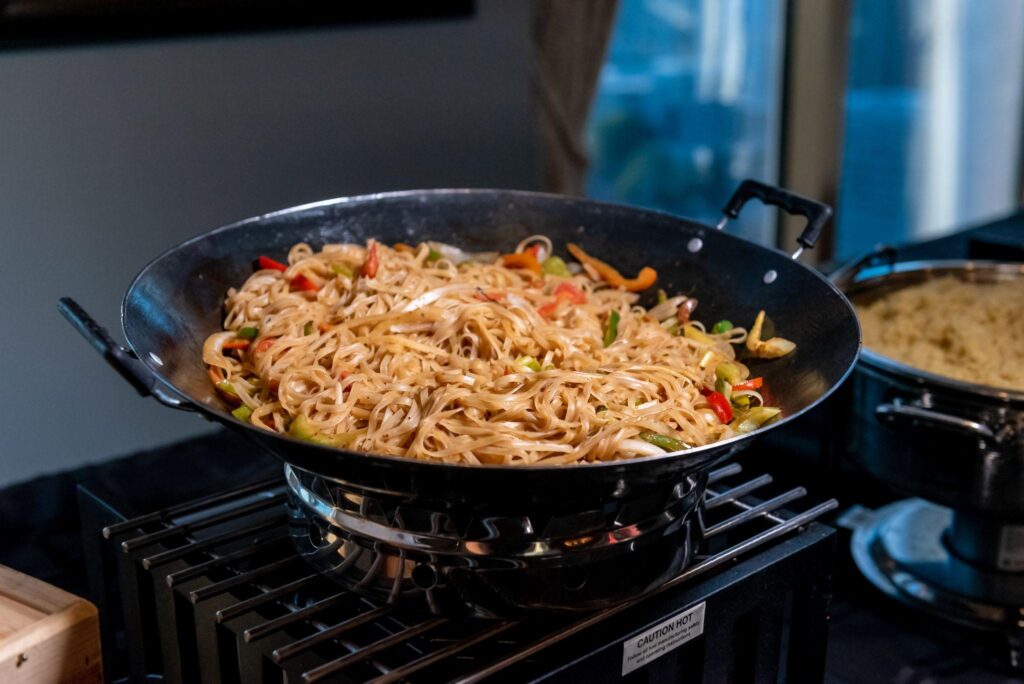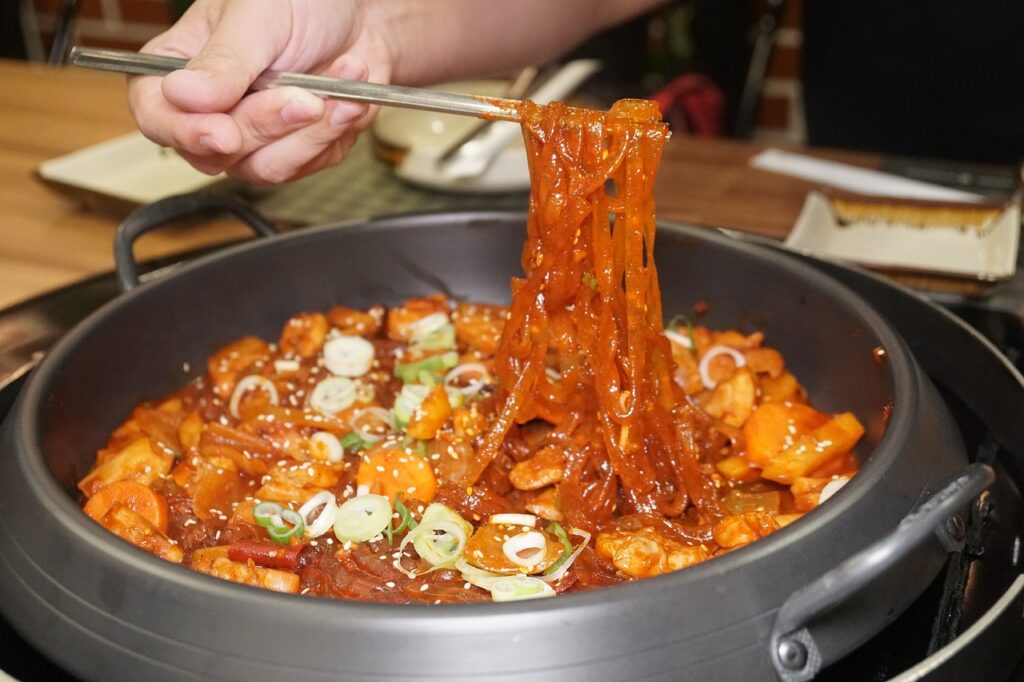Korean Recipe Noodles: A Blend of Tradition and Flavor
Korean cuisine offers a symphony of tastes and textures that enamor food enthusiasts globally. Within its culinary treasure trove, Korean noodle recipes emerge as a pivotal main dish, representing the nation’s rich history and scrumptious flavors.
This article promises a look into the world of Korean noodles, tracing their historical roots and teaching you how to recreate the magic in your kitchen. Let’s embark on this flavorful journey.
A Brief History of Noodles in Korea
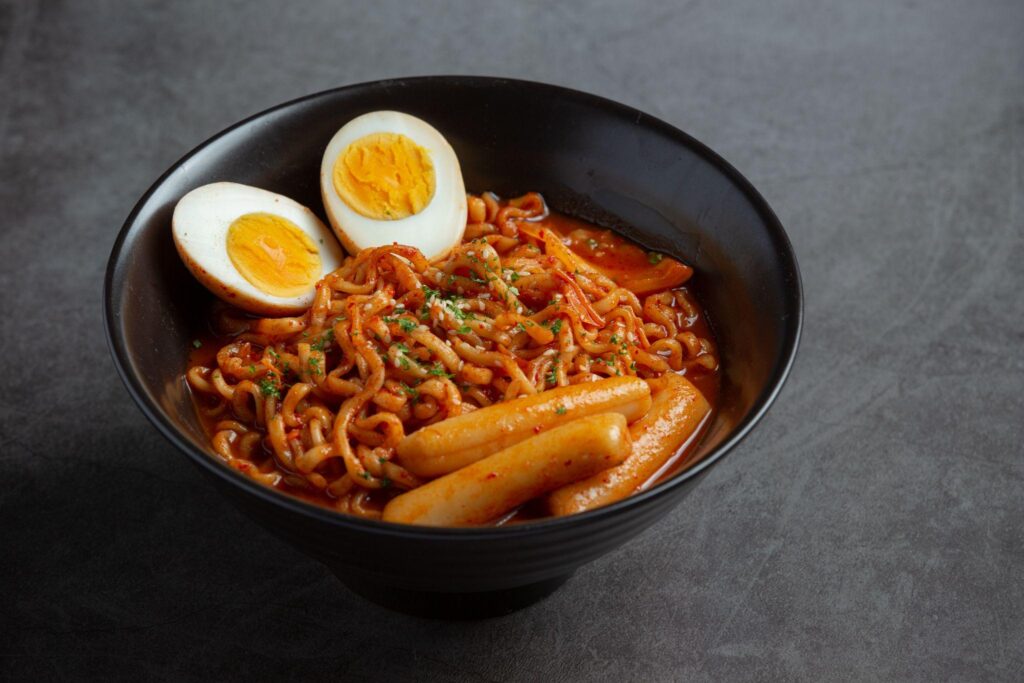
Noodles are an integral dish in Korean cuisine, reflecting both tradition and innovation in the culture. Their presence on the Korean food scene has evolved significantly, weaving a tale of taste and culture.
The Beginnings and Symbolism
The origins of Korean noodle recipes trace back centuries. During ancient times, noodles, often made from rice or buckwheat, were more than just a dish. They held profound symbolic meaning, especially in traditional ceremonies. For instance, the long strands of noodles represented longevity and prosperity, a hope for a long and prosperous life.
Ingredient Influence and Evolution
Over the years, the influence of neighboring civilizations and the availability of native ingredients led to several noodle dishes in Korean cuisine. Sweet potato noodles, crafted from sweet potato starch, became widely popular and paved the way for creating the renowned dish, Japchae. These glass noodles, stir-fried with vegetables in sesame oil and seasoned with soy sauce, embody the harmony of ingredients and techniques.
Another pivotal moment in the history of noodles was the introduction of udon noodles. Though originally from Japan, udon found its way into the Korean culinary scene, leading to a spicy Korean version of udon seasoned with red pepper flakes and gochujang sauce.
The Age of Spice and Stir Fry
With the growth in trade and the exchange of cooking techniques, spicy Korean food and noodles began to gain traction. The stir fry method, which involved cooking food rapidly over high or medium heat, became a preferred method to prepare noodles. With ingredients like green onions, bell peppers, and shiitake mushrooms, these stir-fried vegetables added depth to the noodle dish. The rich flavors were further accentuated with the liberal use of sesame oil and soy sauce.
Spicy noodles, known for their fiery kick, became synonymous with Korean food. It was not just the addition of spicy condiments but also the balance of flavors. The spicy was complemented by sweet, sour, and umami – a true dance of flavors in every bite.
Modern Touch and Global Popularity
Modern-day Korean recipes have introduced various innovations to traditional dishes. The inclusion of instant noodles, the creation of the fusion dish Ram Don (from the movie Parasite), and the embracing of gluten-free options using rice noodles show the adaptability of Korean food.
A testament to the global reach of Korean spicy noodles is their presence in grocery stores worldwide. Whether you’re searching for the chewy texture of sweet potato noodles, the spice of gochujang sauce, or the comforting warmth of a bowl of udon, there’s a Korean noodle dish waiting to tantalize your taste buds.
You may also like: Vegetarian-Friendly Food: Sustainable and Ethical Choices
Korea on a Plate: Korean Noodle Recipes to Savor
Korea offers a diverse noodle landscape. Each dish tells a story of flavor and tradition. Let’s look at Korea’s beloved noodle varieties.
Japchae: The Glass Noodle Delight
Japchae, one of the classic Korean foods noodle recipes, is made with sweet potato noodles, known as glass noodles, due to their translucent appearance. They are stir-fried with thinly sliced beef strips, bell peppers, green onions, and shiitake mushrooms. The sauce combines soy sauce, sesame oil, and a hint of sugar.
Ingredients:
- 200g sweet potato noodles (glass noodles)
- 150g thinly sliced beef strips
- 1 bell pepper, thinly sliced
- 2 green onions, chopped
- 3 shiitake mushrooms, thinly sliced
- 3 tbsp soy sauce
- 2 tbsp sesame oil
- 1 tbsp sugar
- Sesame seeds for garnish
Instructions:
- Cook sweet potato noodles in boiling water as per package instructions. Drain and set aside.
- In a large mixing bowl, combine beef with 1 tbsp soy sauce and sugar. Marinate for 20 minutes.
- Heat 1 tbsp sesame oil over medium heat. Stir fry beef until completely cooked.
- Add bell pepper, green onions, and shiitake mushrooms, stir frying for 3-4 minutes.
- Add cooked noodles, remaining soy sauce, and sesame oil. Stir fry until well combined.
- Serve warm, garnished with sesame seeds.
Why we love this: Japchae offers a chewy texture from the sweet potato starch noodles paired with the savory elements of beef and sauce, resulting in a delightful play on textures and flavors.
Bibim Guksu: Spicy Cold Noodles
This spicy Korean noodle recipe, Bibim Guksu, uses thin wheat noodles doused in a spicy sauce of gochujang paste, vinegar, and sugar. Topped with thinly sliced cucumbers, a hard-boiled egg, and a sprinkle of sesame seeds, it’s a refreshing dish especially popular during summer.
Ingredients:
- 200g thin wheat noodles
- 1 cucumber, thinly sliced
- 1 hard-boiled egg
- 3 tbsp gochujang paste
- 2 tbsp vinegar
- 1 tbsp sugar
- Sesame seeds for garnish
Instructions:
- Cook noodles in boiling water according to package instructions. Drain and rinse under cold water.
- In a small bowl, combine gochujang paste, vinegar, and sugar.
- Toss noodles with the sauce, ensuring they’re well coated.
- Serve topped with sliced cucumber, a halved hard-boiled egg, and a sprinkle of sesame seeds.
Why we love this: This dish blends spicy with cold, offering a unique sensation on the palate, making it an ideal noodle dish for hot weather.
Udon Stir Fry with Vegetables
Udon noodles, thicker and chewier, are perfect for stir-fries. In this Korean version, they’re stir-fried with a mix of vegetables like bok choy, bell pepper, and green onion in a sauce made from soy sauce, sesame oil, and gochujang sauce. Optionally, add thinly sliced beef strips or a fried egg for protein.
Ingredients:
- 200g udon noodles
- 1 bok choy, chopped
- 1 bell pepper, sliced
- 1 green onion, sliced
- 150g thinly sliced beef strips (optional)
- 2 tbsp soy sauce
- 2 tbsp sesame oil
- 1 tbsp gochujang sauce
Instructions:
- Cook udon noodles according to package instructions. Drain and set aside.
- In a large wok or pan, heat sesame oil over medium heat. Add beef strips and stir fry until cooked.
- Add bok choy, bell pepper, and green onion. Continue stir frying for 3-4 minutes.
- Add cooked noodles, soy sauce, and gochujang sauce. Mix well.
- Serve warm.
Why we love this: The thick udon noodles soak up the spicy and savory sauce perfectly, providing a hearty dish that’s sure to satisfy.
You may also like: 10 Low Carb Noodles You Will Love
Ram Don (Jjapaguri): The Fusion Delight
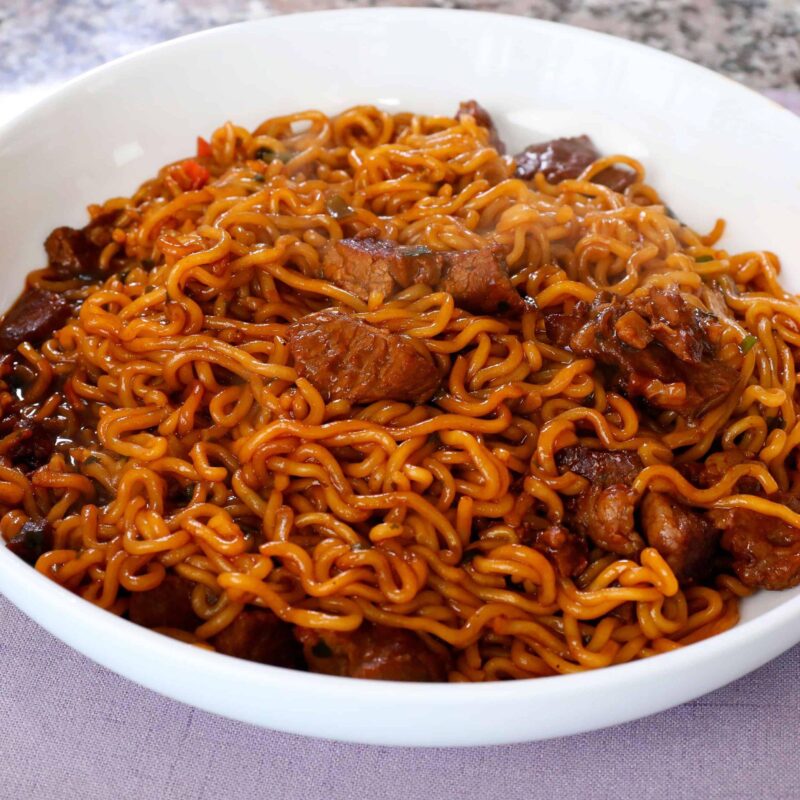
Source: Maangchi.com
Emerging from the cinematic world, Ram Don combines two types of instant noodles: udon and spicy Korean noodles. Topped with rich beef marinade, this dish became internationally recognized and loved.
Ingredients:
- 1 packet udon noodles
- 1 packet spicy Korean noodles
- 150g beef, cut into cubes
- 2 tbsp soy sauce
- 1 tbsp sesame oil
- 1 tsp sugar
Instructions:
- Cook both noodle types according to their package instructions in separate pots. Drain and set aside.
- In a pan, heat sesame oil over medium heat. Add beef cubes and stir fry until browned and cooked through.
- Add soy sauce and sugar to the beef, cooking for an additional 2 minutes.
- Combine both noodles in a large mixing bowl. Add the beef and mix well.
- Serve immediately.
Why we love this: Ram Don is a beautiful fusion of two popular recipes, combining chewy udon with spicy Korean noodles, topped with luxurious beef. It’s a quick, savory concoction that represents modern Korean cuisine, fusing the old with the new.
Dak Kalguksu: Chicken Knife Noodles
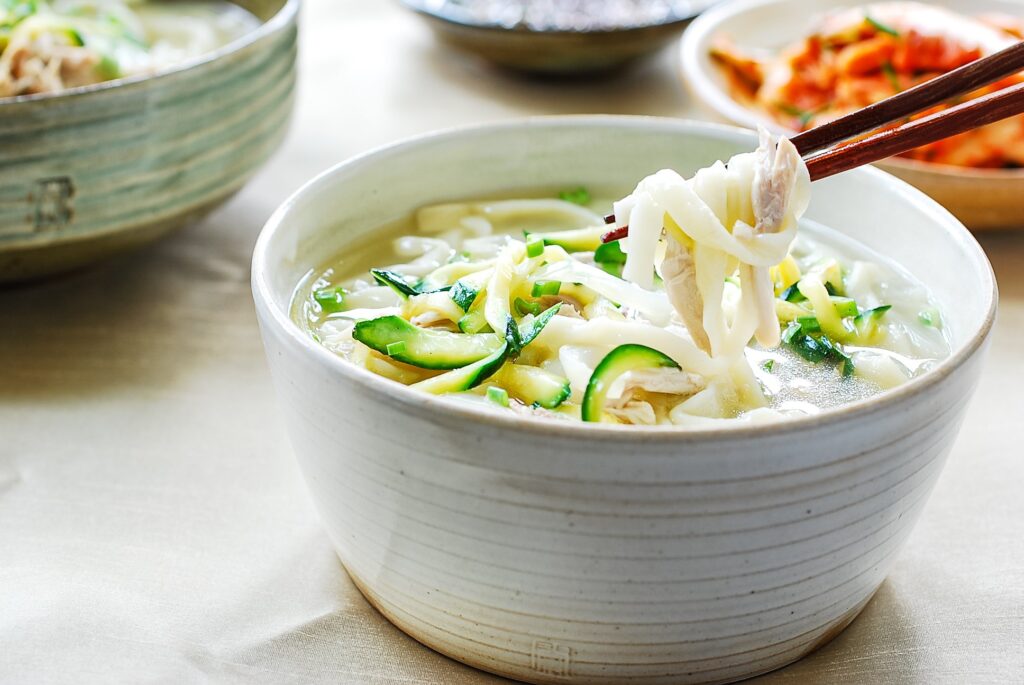
Source: Korean Bapsang
A warming noodle soup, it features hand-cut wheat noodles boiled with a chicken broth. Added are green onions, shiitake mushrooms, and thinly sliced chicken. The sauce ingredients, predominantly soy sauce and a dash of sesame oil, provide depth.
Ingredients:
- 200g fresh wheat noodles (or substitute with udon noodles)
- 300g chicken breast or thighs, thinly sliced
- 2 liters chicken broth
- 2 green onions, chopped
- 3 cloves garlic, minced
- 1 shiitake mushroom, thinly sliced
- 1 bok choy, chopped
- 1 red bell pepper, thinly sliced
- 2 tbsp soy sauce
- 1 tbsp rice wine
- 2 tsp sesame oil
- 1 tsp red pepper flakes (adjust according to spice level)
- Sesame seeds and chopped green onions for garnish
Instructions:
- In a large pot, bring chicken broth to a boil. Add the thinly sliced chicken pieces and let it simmer until the chicken is completely cooked.
- In a small bowl, combine soy sauce, rice wine, sesame oil, minced garlic, and red pepper flakes to create the sauce.
- Add the sauce to the pot and mix well.
- Introduce the fresh wheat noodles to the pot and allow them to cook until they have a chewy texture.
- Toss in the bok choy, bell pepper, and shiitake mushrooms. Continue to cook until vegetables are slightly tender but still have a bite.
- Turn off the heat and add in the green onions.
- Serve the noodle dish hot in a bowl, garnished with sesame seeds and extra chopped green onions on top.
Why we love this: Dak Kalguksu offers a comforting bowl of hearty noodles drenched in a flavorful chicken broth, punctuated by fresh vegetables and tender chicken pieces. It’s a warming dish perfect for cold nights or when you need a bowl of good food to lift your spirits.
Essential Side Dishes for Your Korean Noodles
The beauty of noodles lies in their versatility and the myriad of complementary side dishes that elevate the overall dining experience. Side dishes, or “banchan”, are integral to Korean cuisine. Let’s look at some side dishes that will complement and elevate your favorite Korean food noodles.
Kimchi: A Fermented Delight
A quintessential element in the Korean culinary landscape, Kimchi is a fermented vegetable dish, most commonly made from napa cabbage and Korean radishes. You can season your Kimchi with spicy red pepper, garlic, ginger, and fish sauce. Its tangy, spicy, and umami-packed taste, combined with a vibrant hue and crunch, elevates any meal.
Ingredients:
- Napa cabbage
- Salt
- Red pepper flakes
- Chopped green onions
- Ginger (grated)
- Garlic (minced)
Instructions:
- Cut the cabbage into quarters. Sprinkle salt between leaves. Let it rest for 2 hours.
- Rinse the salted cabbage. Squeeze out excess water.
- Prepare a paste with red pepper flakes, green onions, ginger, and garlic.
- Apply the paste to each cabbage leaf.
- Place it in a jar, ensuring it’s packed tightly. Let it ferment for a week before serving.
Why this is perfect with your Korean noodles: Kimchi’s tangy fermentation balances the richness of the noodles. Its spiciness amplifies dishes like spicy noodles, while its crunch contrasts the chewy texture of udon or sweet potato noodles. Combined, they create a harmonious blend of flavors and textures.
Korean Spinach Salad (Sigeumchi-namul)
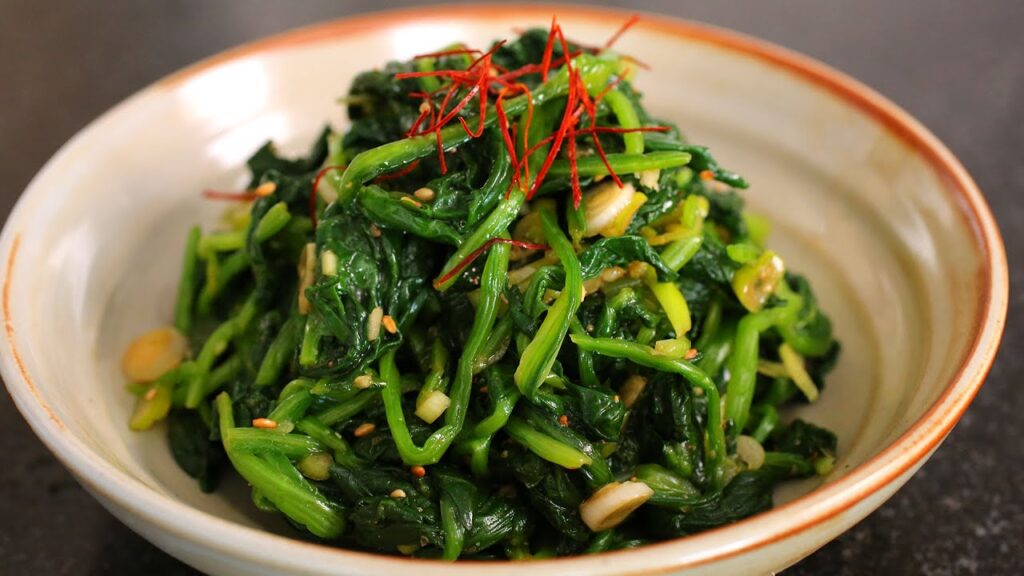
Source: Maangchi.com
A traditional Korean spinach salad, blanched and seasoned with soy sauce, sesame oil, and garlic. Enhanced with green onions and sesame seeds, it offers a nutty, savory bite ideal beside rich dishes.
Ingredients:
- 250g baby spinach
- 1 tbsp soy sauce
- 1 tbsp sesame oil
- 1 tsp sesame seeds
- 1 green onion, finely chopped
- 1 clove garlic, minced
- Salt to taste
Instructions:
- Bring a pot of water to boil and blanch the baby spinach for about 1 minute, until wilted.
- Drain and rinse the spinach in cold water, then squeeze out excess water.
- In a large mixing bowl, combine the spinach with soy sauce, sesame oil, garlic, green onion, and sesame seeds.
- Mix well and adjust seasoning with salt as needed. Serve immediately.
Why this is perfect with your Korean noodles: The refreshing and slightly nutty flavors of this spinach salad contrast beautifully with spicy Korean noodles. The sesame oil adds a depth of flavor, enhancing the overall taste of your noodle dish.
You may also like: 10 Best Soju Flavors on the Market
Stir-Fried Shiitake Mushrooms
Earthy shiitake mushrooms stir-fried in soy sauce and sesame oil, achieving tender umami flavors. Accented with green onions, garlic, and a sesame seed topping, it melds crispy and chewy textures.
Ingredients:
- 150g shiitake mushrooms, thinly sliced
- 1 tbsp soy sauce
- 1 tsp sesame oil
- 1 tbsp vegetable oil
- 1 green onion, chopped
- 1 clove garlic, minced
- 1 tsp sesame seeds
Instructions:
- Heat vegetable oil in a pan over medium heat.
- Add shiitake mushrooms and stir fry them for about 4-5 minutes until they soften.
- Stir in garlic and fry for another minute.
- Add soy sauce and sesame oil, stirring well to coat the mushrooms.
- Remove from heat, garnish with chopped green onion and sesame seeds.
Why this is perfect with your Korean noodles: The earthy flavors of shiitake mushrooms pair exceptionally well with the chewy texture of noodles, providing a balance in mouthfeel. Their umami essence complements the rich sauces of many Korean noodle dishes.
Spicy Korean Cucumber Salad (Oi Muchim)
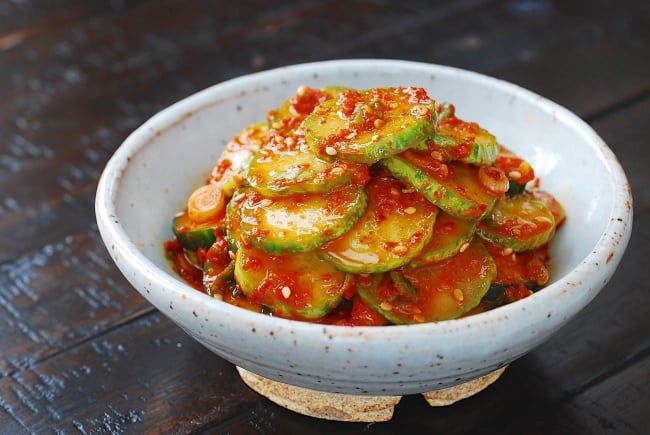
Source: Korean Bapsang
A vibrant cucumber salad in spicy gochujang-based sauce, tinged with rice vinegar and sesame oil. Topped with green onions, sesame seeds, and red pepper, it delivers a spicy crunch, balancing milder mains.
Ingredients:
- 2 medium-sized cucumbers, thinly sliced
- 1 tsp salt
- 1 tbsp gochujang sauce
- 1 tbsp rice vinegar
- 1 tbsp sesame oil
- 1 green onion, chopped
- 1 tsp sesame seeds
- 1 tsp red pepper flakes
Instructions:
- Place cucumber slices in a large mixing bowl, sprinkle with salt, and set aside for 10 minutes.
- Drain the water released from cucumbers and add gochujang sauce, rice vinegar, sesame oil, and red pepper flakes.
- Toss well until cucumbers are well-coated with the sauce.
- Garnish with chopped green onions and sesame seeds before serving.
Why this is perfect with your Korean noodles: The crunchy freshness of cucumbers combined with the spicy kick of the gochujang sauce offers a delightful texture and flavor contrast to any noodle dish. It’s a palate cleanser and a spice enhancer in one!
Pairing a main dish of noodles with these side dishes creates a balanced, flavorful, and authentic Korean meal. From the spicy kick of the cucumber salad to the umami-rich mushrooms and refreshing spinach salad, these banchan ensure a multi-dimensional dining experience.
But don’t just stop here. You can immerse yourself further into the world of Korean food, noodle recipes and cuisine and explore how different flavors and textures can transform your next noodle feast. Whether served with spicy noodles or a mild udon noodle dish, these sides are sure to be a hit.
Crafting the Authentic Korean Noodles
Korean noodle dishes are as much about the process as they are about the ingredients. Fresh produce from local Asian markets can work wonders. The balance between ingredients like soy sauce and sesame oil and spicy condiments like gochujang sauce ensures an authentic taste.
These Korean noodle recipes and Korean cooking in general emphasize presentation. Moreover, dishes are served not just for the palate but for the eyes too. The juxtaposition of colors, textures, and layers can make the dish come alive.
Let’s take a closer look at the flavors and textures that make Korean noodles a global favorite.
Ingredients: The Heart of Korean Noodles
When crafting authentic Korean noodles, one must prioritize the ingredients. They dictate the dish’s taste, texture, and overall appeal.
- Soy Sauce: A foundation in many Korean foods, soy sauce lends a deep, salty flavor, making it indispensable in a Korean noodle dish.
- Sweet Potato Noodles: Recognized for their chewy texture, these are the star in Japchae, a beloved Korean noodle dish.
- Udon Noodles: Thick and hearty, udon noodles find their place in warming soups and stir-fry dishes.
- Glass Noodles: Made from sweet potato starch, these translucent noodles offer a unique chewy texture, perfect for various noodle dishes.
- Gochujang Sauce: This spicy, savory, sweet sauce is often paired with Korean spicy noodles for that extra kick.
Techniques and Tips
To truly emulate Korean cooking, one must master certain techniques.
- Stir Fry: A fundamental method, especially when crafting dishes like spicy Korean noodles stir fry. Here, ingredients like thinly sliced beef strips, bell peppers, shiitake mushrooms, and green onions are cooked on medium heat, ensuring they retain flavor and crunch.
- Boiling: Noodles, whether sweet potato noodles or udon noodles, must be boiled to perfection. Not too soft, and not too firm—achieving that perfect chewy texture is key. However, always refer to the package instructions or until they’re completely cooked.
- Sauce Mixing: A good sauce can elevate any noodle dish. Mix sauce ingredients like soy sauce, sesame oil, gochujang paste, and red pepper flakes in a small bowl. Adjust the spice level to your liking for the perfect spicy Korean kick.
Crafting the Perfect Bowl
Once you’ve prepared your ingredients and mastered the techniques, it’s time to put it all together.
- Layering: Start with a base of your chosen noodles. Add stir-fried vegetables, thinly sliced protein of your choice, or a fried egg for added depth.
- Saucing: Generously ladle on your prepared sauce. Whether it’s a spicy gochujang sauce for those who love their Korean spicy noodles or a milder soy-based sauce for subtler palates, ensure every strand is well-coated.
- Garnishing: Finish with a sprinkle of sesame seeds, chopped green onions, or even some bok choy for freshness. For those who love a bit of crunch, kimchi is a perfect side dish.
Crafting the perfect Korean foods and noodles recipes is an art. It’s about understanding the balance of flavors, mastering the cooking techniques, and using the right ingredients. Whether you’re recreating a classic from the Korean menu or putting a unique twist on a traditional dish, the journey of making authentic Korean noodles is one filled with delicious rewards.
Read more: Gaming god? These Filipino mythology-inspired games can make you one
In Conclusion
Embarking on the Korean noodle journey introduces one to the fusion of age-old traditions with the burst of flavors. Each dish reflects Korea’s culinary heritage.
As the world’s palate evolves, dishes like Japchae and Ramyeon have found fans beyond Korea’s borders. It’s heartening to see the global appreciation of Korean foods noodles hold a special place in that narrative.
As you savor the last bite of your homemade Korean noodle dish, remember, you’re not just relishing good food. You’re partaking in a tradition, a story, a legacy. The world of Korean cuisine awaits your exploration. Immerse yourself, experiment, and, above all, enjoy every bite.

